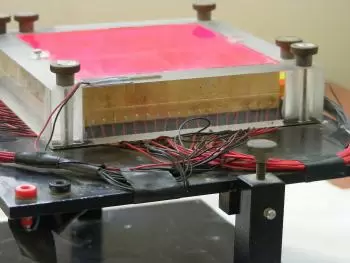
A luminescent solar concentrator (LSC) is a device capable of absorbing and concentrating sunlight for the production of electrical energy. Luminescent solar concentrators capture solar radiation over a large area. Subsequently, they convert this radiation into luminescence and direct it to a smaller target where there is a photovoltaic receiver.
The acronym LSC comes from the English Luminescent Solar Concentrator.
LSC panels are cheaper than classic photovoltaic panels. In fact, they are made of plastic or glass plates on which luminescent molecules are deposited.
The technology for this form of renewable energy has been known since the 1960s, but has been progressively abandoned due to low efficiency and difficulties in producing suitable dyes.
Functioning
LSC luminescent solar concentrators are transparent active photographic plates capable of absorbing light from a broad spectrum of solar radiation.
These elements use special luminescent dyes capable of capturing light and emitting it within the plate. The radiation is then transported towards the edges, through successive reflections within the plate. At the edges of the panels are photovoltaic cells that convert sunlight into electricity.
The concentration system has many advantages. Overheating of silicon cells is reduced, which often causes reduced efficiency and loss of energy as heat.
Additionally, as it passes through the solar panels, the incident radiation is converted into wavelengths that maximize the efficiency of the cells.
Advantages
Among the advantages of luminescent solar concentrators are:
-
Higher efficiency: They make it possible to shift the shortwave radiation region of the solar spectrum to a longer wavelength range. Within this range the conversion efficiency of solar cells is higher.
-
Use of diffuse solar radiation. Achieving a high optical concentration of sunlight in stationary devices due to the ability to capture not only direct, but also diffuse light.
-
Prevents solar cells from overheating.
-
The use of the LSC in combination with a solar photovoltaic system for the production of electrical energy will increase overall efficiency.
-
The use of small area photovoltaic cells allows the use of more efficient and expensive solar cells. Solar cells are what convert light energy into electricity.
Disadvantages
This type of solar concentrators has some drawbacks:
- The "loss cone" exerts a fairly large influence on the efficiency of the structure through which a part of the re-emitted light leaves the waveguide volume and can no longer be used for conversion into electrical energy.
- To reduce losses within the waveguide, it is necessary to decrease the critical angle by increasing its refractive index. However, in this case, the loss due to reflection of sunlight increases due to an increase in the external critical angle. The solution to this problem is possible by applying a coating with an intermediate refractive index to the air-waveguide interface, as a result of which losses due to reflection and radiation output from the waveguide will decrease.
- Loss as a result of reabsorption of re-emitted light is inextricably linked to the "loss cone." During the movement of radiation along the waveguide towards the ends, it can be reabsorbed and re-emitted. Since the luminescence is quasi-isotropic, some of the radiation is lost again through the "loss cone".
Use and applications
Solar energy structures consisting of LSCs and PV systems can be integrated into urban infrastructure by using existing artificial surfaces. These structures can be, for example, translucent building structures, such as windows, stained glass, cornices.
The introduction of these systems into mobile and woven electronic devices (e.g. backpacks) is promising. The cost of a structure consisting of a luminescent solar concentrator, in combination with a solar cell, will be less than the cost of a pure solar cell of similar efficiency. This is due to the fact that in the first case, the area of the photovoltaic panel will be less.
Used materials
Plastics, glass or organic solvents located between the plastic or glass sheets can be used as LSC matrix material. Polymeric materials are best suited for these purposes due to their optical and operational properties as well as their manufacturability. For these purposes, polymethyl methacrylate and polystyrene are most often used.
Organic dyes, compounds with rare metal ions and quantum dots, of which the former are the most widely used due to their high quantum yield, ease of use and low cost, can act as luminescent material.
Its concentration for effective operation does not exceed 1% of the mass, which has a positive effect on the cost of the structure.